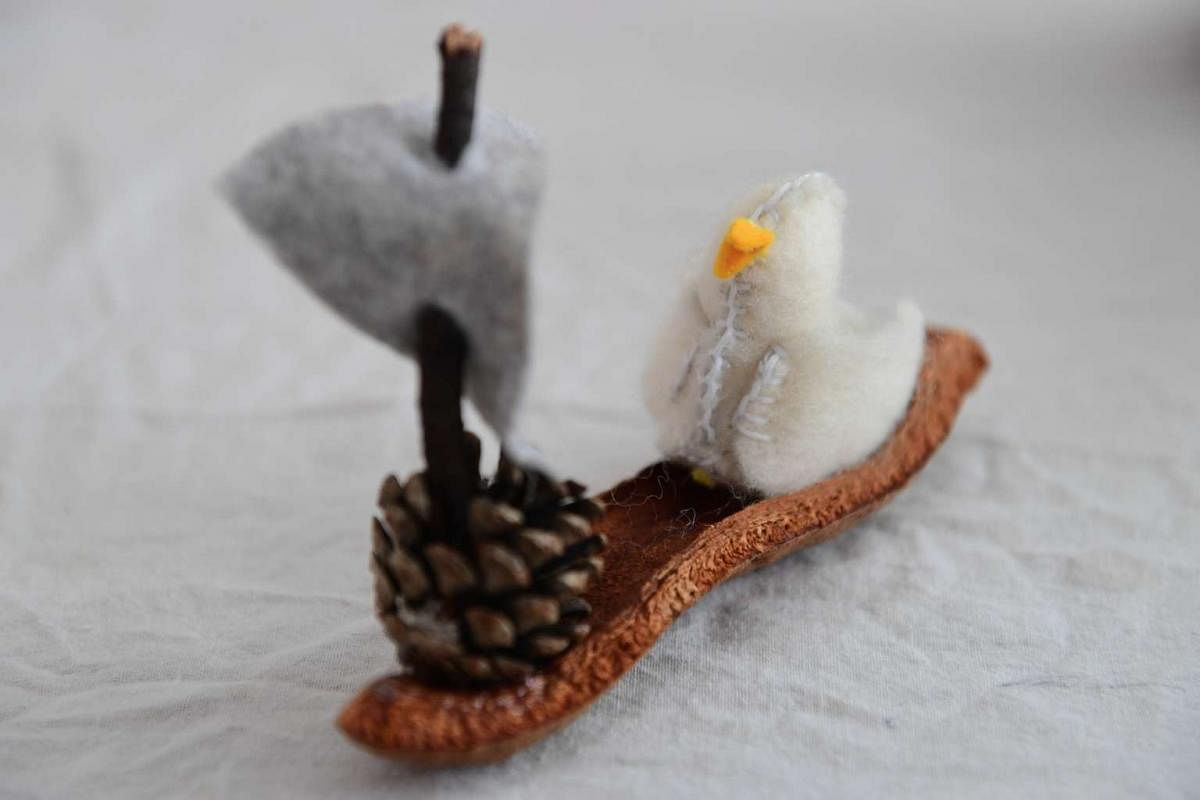-
Make your own toy washing machine
-

What you will need• A cardboard box
• Styrofoam board
• Two empty plastic• mineral-water bottles that can hold 600ml of liquid
• Mahjong paper or any kind of paper that is white
• Yellow corrugated paper or any other colour you wish
• Laminated plastic sheets or overhead projector sheets
• A pair of scissors or a penknife, UHU glue, scotch tape, double-sided tape
• A mobile phone or digital camera

Method
1. Choose a cardboard box for the toy washing machine. The one here was made using a box that is 57cm high, 38cm long and 26.5cm wide.
2. Start with the door. Draw the outline of a circle (diameter 26cm), leaving a rim of about 5cm. Cut out most of this circle, but leave some space to make a hinge. Cut and tape the plastic sheet over the hole to form the glass door.
3. To make the detergent compartment, cut a rectangle (the dimensions here are about 15cm x 8cm) in the top left-hand corner of the cardboard box.
4. Use the styrofoam board to make the detergent compartment (dimensions 22cm x 14cm X 7cm). You will need one rectangular piece for the base and two long rectangular pieces and two shorter pieces for the four sides. Join the five pieces together with UHU glue and tape. Slot the compartment into the washing machine.
5. Take a photo of the display panel on your washing machine at home, which shows the wash settings and temperatures. Enlarge the photo if desired, print it and laminate it. Stick this display panel next to the detergent compartment.
6. Cut two smaller holes (diameter 3cm), one above the other, near the top right-hand corner of the box for the washing machine knobs. Cut the tops of two empty plastic mineral-water bottles that can hold 600ml of water. Push the top of the bottle out from the inside of the toy washing machine and screw on the cap.
7. Wrap the toy washing machine in mahjong paper or any paper that is white. Add other trimmings as desired.
-
• Information provided by Mrs Pauline Ngerng and Preschool Resources, an online community that provides resources for children to learn through play.
Making toys for their kids
The handmade toys help their children and grandchildren learn through play and cut down on computer screen time, say parents and grandparents





After Mrs Pauline Ngerng, 58, bought a doll house for her two- year-old granddaughter, Tanya Sekaran, she decided to make a playground set to accompany it last year, using materials such as styrofoam, felt and toilet paper rolls.
She did it not only because Tanya liked to go to the playground, but also because she wanted to teach the toddler prepositions as she moved toy figurines up the ladder, down the slide, through the tunnel and on the swing.
"By making toys for my grandchildren, I can tailor the toys to their learning needs," says Mrs Ngerng.
The former teacher resigned from the profession about five years ago to help care for Tanya and her cousins, brothers Gerard, four, and Julian, who is nearly two.
She says that being a primary school teacher for more than 30 years helps her gauge whether her grandchildren are ready to learn certain concepts.
She gets ideas for her handmade toys and games, which take her between a few hours and days to make, from photo-sharing site Pinterest and YouTube videos.
Last September, she made a toy washing machine with turnable knobs for all three grandchildren, in part because she wanted them to develop their finger muscles and hone their fine motor skills.
She is part of a growing movement of parents and grandparents who are making toys and games for their children and grandchildren.
Their reasons for doing so range from educational considerations to cost-effectiveness to a desire to cut down on computer screen time.
Making one's own toys and games is one of the activities showcased in Preschool Resources, an online community that provides and shares resources and ideas for children to learn through play.
Mr Edmund Lim, 37, founded Preschool Resources, comprising a website and a Facebook group, in the middle of 2015 because he felt that his daughters, aged three and five, learnt well through play.
When his younger daughter Jannah was two, for instance, he and his wife created a game for her by pasting animal pictures on cards and asking her to match them with animal names written in Chinese.
"I wanted my children to have access to activities and resources that encompass a whole range of skills such as literacy, numeracy, sorting and matching patterns, and art and craft," says Mr Lim, who works as a Web marketing manager.
He felt that setting up Preschool Resources - whose closed Facebook group has more than 16,000 members less than two years after he launched it - was "an effective way to share resources for children".
Ms Vivian Wang, 35, an administrative executive in the banking industry, finds it satisfying when her only child, Seth, likes the toys she makes. These include a garage, a post box and a makeshift car, all made mostly out of cardboard.
Playing with her three-year-old is also a bonding experience, says Ms Wang, who is a member of Preschool Resources.
She feels that making toys and games is easy and economical.
She uses simple materials, such as cardboard, as well as magnets sold at budget store Daiso.
In contrast, bigger and more expensive store-bought toys can turn out to be "white elephants" as children may not be entertained by them for long, she says.
She likes that some toys she has made can be used in multiple ways.
For instance, Seth learnt to match colours and count as well as the concept of buying and selling through a game she made for him, involving DIY ice cream cones.
Some parents prefer to make their own toys because the type of material used is important to them.
Housewife Doreen Eng, 44, for example, makes toys for her daughters, aged four and six, using natural materials because she believes such materials nourish the senses and contribute to the children's holistic development.
She is a co-founder of Sprouting Seeds, an initiative that organises play groups for children in nature areas, which is inspired by the Waldorf education philosophy that emphasises outdoor play and being connected to nature.
According to the Waldorf philosophy, the senses that are cultivated in early childhood directly relate to aspects of adult life.
For example, the development of the sense of touch relates to how social boundaries are experienced.
Ms Eng made unicorn hobby horses last year, where she dyed the unicorn's mane using fruit and spices such as blueberries and turmeric.
Her emphasis on imaginative play and natural materials, including wool and wood, means she also limits electronics and screen time for her girls, Arianna, six, and Celeste, four, whom she says hardly watch television or play games on iPads, which she feels make children jittery.
"I've observed that my daughters play longer with toys made from natural materials compared with plastic toys," says Ms Eng, who estimates that only 5 per cent of her children's toys, usually given to them as presents, are made of plastic.
Housewife Queenny Choong, 43, is also inspired by Waldorf philosophy, for instance, making a Waldorf doll - which typically has minimal or no facial features to encourage kids to imagine its expression - for her daughter Chua Yun Ee, aged four.
Ms Choong encourages Yun Ee and her elder brother Yun Wei, five, to play with simple objects such as wooden blocks and pebbles.
"Kids may not cherish toys that are bought. Simple toys such as wooden shapes that can be made into a car, then a house, will help them to be more creative," she says.
Join ST's Telegram channel and get the latest breaking news delivered to you.
A version of this article appeared in the print edition of The Sunday Times on March 19, 2017, with the headline Making toys for their kids. Subscribe

